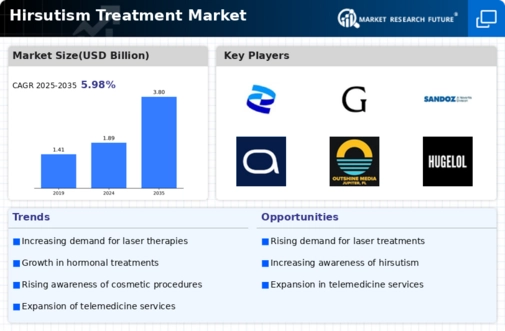Increasing Prevalence of Hirsutism
The rising incidence of hirsutism, particularly among women, is a notable driver for the Hirsutism Treatment Market. Studies indicate that approximately 5 to 10% of women of reproductive age experience this condition, which can lead to psychological distress and social stigma. As awareness of hirsutism grows, more individuals seek treatment options, thereby expanding the market. The increasing prevalence is attributed to factors such as hormonal imbalances, polycystic ovary syndrome, and lifestyle changes. This trend suggests a sustained demand for effective treatment solutions, including medications and cosmetic procedures, which are integral to the Hirsutism Treatment Market.
Growing Focus on Aesthetic Treatments
The increasing emphasis on aesthetics and personal grooming is significantly influencing the Hirsutism Treatment Market. As societal standards of beauty evolve, individuals are more inclined to seek treatments that enhance their appearance. This trend is particularly pronounced among younger demographics who prioritize self-image and confidence. The rise of social media platforms has further amplified this focus, as individuals showcase their grooming routines and results. Consequently, the demand for effective hirsutism treatments, including both medical and cosmetic options, is expected to rise. This shift in consumer behavior indicates a robust market potential for the Hirsutism Treatment Market, as more individuals seek solutions to manage unwanted hair.
Advancements in Treatment Technologies
Technological innovations in the Hirsutism Treatment Market are transforming the landscape of hair removal and management. Laser hair removal and electrolysis have gained traction due to their effectiveness and long-lasting results. The introduction of new devices and techniques enhances patient comfort and reduces treatment times. Furthermore, the development of topical treatments and hormonal therapies is expanding the range of options available to patients. As these technologies evolve, they are likely to attract more individuals seeking effective solutions for hirsutism, thereby driving growth in the Hirsutism Treatment Market. The market is projected to witness a compound annual growth rate of around 8% over the next few years.
Increased Access to Healthcare Services
The expansion of healthcare services and improved access to medical care are pivotal factors driving the Hirsutism Treatment Market. As healthcare systems evolve, more patients are able to consult with specialists regarding their hirsutism concerns. This increased accessibility is facilitated by telemedicine and online consultations, which allow individuals to seek advice without geographical constraints. Moreover, the integration of hirsutism treatments into broader women's health services enhances awareness and encourages treatment uptake. As healthcare access continues to improve, it is anticipated that more individuals will pursue effective solutions for hirsutism, thereby contributing to the growth of the Hirsutism Treatment Market.
Rising Demand for Personalized Medicine
The trend towards personalized medicine is emerging as a significant driver in the Hirsutism Treatment Market. Patients are increasingly seeking tailored treatment plans that address their specific needs and conditions. This shift is supported by advancements in genetic testing and hormonal profiling, which enable healthcare providers to offer more effective and individualized treatment options. As patients become more informed and proactive about their health, the demand for personalized approaches to hirsutism management is likely to increase. This trend not only enhances patient satisfaction but also drives market growth, as healthcare providers adapt to meet the evolving expectations of individuals seeking solutions in the Hirsutism Treatment Market.


















Leave a Comment